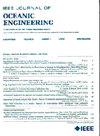水下环境下主瓣干扰的鲁棒宽带波束空间自适应波束形成
IF 3.8
2区 工程技术
Q1 ENGINEERING, CIVIL
引用次数: 0
摘要
在水声探测中,宽带阵列技术以其强大的抗干扰能力和增强的目标信息获取能力而受到人们的认可。传统的宽带自适应波束形成技术在存在主瓣干扰的情况下面临着主瓣失真的挑战,从而降低了目标检测的有效性。针对这一困境,我们提出了一种创新的宽带波束空间自适应波束形成方法。这种方法利用波束空间的独特结构来设计辅助波束,从而在主波束的主瓣区域内呈现最小的幅频响应。我们进一步采用空间响应变化策略来构建频率不变波束形成器,能够在频谱范围内产生一致的定向波束。然后对辅助波束的协方差矩阵进行分解,在波束空间内重构协方差矩阵。这种方法保留了主瓣的完整性。仿真结果证实了我们提出的方法的有效性,证实了它不仅能够保护主瓣免受失真,而且能够衰减副瓣干扰并确保值得赞扬的频率均匀性,所有这些都不依赖于有关干扰性质的先验知识。本文章由计算机程序翻译,如有差异,请以英文原文为准。
Robust Wideband Beamspace Adaptive Beamforming for Mainlobe Jamming in Underwater Environment
In underwater acoustic detection, wideband array technology is recognized for its robust anti-interference capabilities and enhanced target information acquisition. Traditional wideband adaptive beamforming techniques grapple with the challenge of mainlobe distortion in the presence of mianlobe jamming, which diminishes the effectiveness of target detection. Addressing this predicament, we propose an innovative wideband beamspace adaptive beamforming approach. This approach capitalizes on the unique structure of beamspace to devise auxiliary beams expressly engineered to present a minimal amplitude-frequency response within the main beam's mainlobe region. We further employ the spatial response variation strategy to construct a frequency-invariant beamformer, capable of producing consistently oriented beams across a spectrum of frequencies. Subsequently, we decompose the auxiliary beam's covariance matrix and reconstitute the covariance matrix within the beamspace. Such a method preserves the integrity of the mainlobe. The simulation outcomes corroborate the efficacy of our proposed method, confirming its ability to not only safeguard the mainlobe against distortion but also attenuate sidelobe interference and assure commendable frequency uniformity, all achieved without reliance on prior knowledge regarding the nature of the interference.
求助全文
通过发布文献求助,成功后即可免费获取论文全文。
去求助
来源期刊

IEEE Journal of Oceanic Engineering
工程技术-工程:大洋
CiteScore
9.60
自引率
12.20%
发文量
86
审稿时长
12 months
期刊介绍:
The IEEE Journal of Oceanic Engineering (ISSN 0364-9059) is the online-only quarterly publication of the IEEE Oceanic Engineering Society (IEEE OES). The scope of the Journal is the field of interest of the IEEE OES, which encompasses all aspects of science, engineering, and technology that address research, development, and operations pertaining to all bodies of water. This includes the creation of new capabilities and technologies from concept design through prototypes, testing, and operational systems to sense, explore, understand, develop, use, and responsibly manage natural resources.
 求助内容:
求助内容: 应助结果提醒方式:
应助结果提醒方式:


